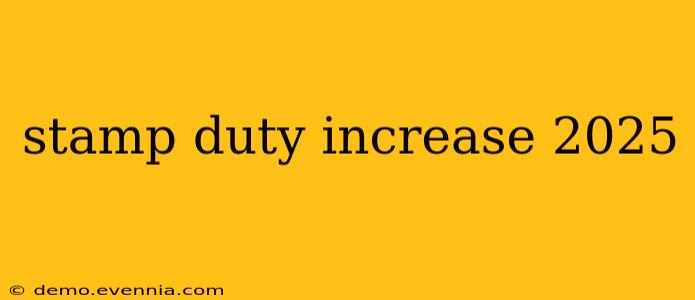The potential for a stamp duty increase in 2025 is a significant concern for many homeowners and prospective buyers. While no concrete changes have been officially announced, understanding the current landscape and potential scenarios is crucial for informed financial planning. This article explores the possibility of a stamp duty increase in 2025, examining the factors that could influence such a decision and offering advice on how to prepare.
Understanding Stamp Duty
Stamp duty is a tax levied on property transactions in many countries. The amount payable depends on the property's value and your circumstances. It's a significant cost for buyers, often adding thousands to the overall purchase price. Therefore, any change in stamp duty rates can dramatically impact affordability and market activity.
Factors Influencing a Potential Stamp Duty Increase in 2025
Several factors could lead to a government considering an increase in stamp duty rates in 2025:
- Government Revenue: Governments often rely on stamp duty as a substantial source of revenue. Increased demand and rising property prices may have temporarily boosted revenue, but a downturn in the market could necessitate adjustments to maintain fiscal targets. An increase in stamp duty could help bridge any revenue shortfall.
- Housing Market Cooling: In periods of rapid house price growth, governments might consider increasing stamp duty as a means of cooling the market and making housing more affordable for first-time buyers. This aims to prevent a speculative bubble and ensure market stability.
- Budgetary Needs: Unforeseen economic events or increased government spending in other areas might necessitate higher tax revenues. Stamp duty, being a readily adjustable tax, could be targeted to meet these budgetary demands.
- Regional Disparities: Governments may consider adjusting stamp duty rates regionally to address specific housing market challenges in different areas. Areas experiencing rapid price growth might see higher rates to manage affordability, while others might receive targeted incentives.
Potential Scenarios and Their Implications
Predicting the future is inherently uncertain. However, we can explore some potential scenarios regarding stamp duty in 2025:
- Scenario 1: No Change: The government might decide against any changes to stamp duty rates, maintaining the status quo. This would offer stability for the housing market but could also imply missed opportunities for revenue generation.
- Scenario 2: Moderate Increase: A small increase in stamp duty rates across the board is possible, aiming to generate additional revenue without significantly impacting market activity. This is likely the most probable scenario if a change is made.
- Scenario 3: Targeted Increases: The government may implement tiered changes, increasing rates for higher-value properties while leaving lower-value properties unaffected. This could target wealthier buyers and stimulate activity in the more affordable segment of the market.
- Scenario 4: Significant Increase: A significant increase is less likely unless there is a substantial shift in market conditions or a pressing need for increased government revenue. Such a move could considerably dampen buyer enthusiasm and lead to a market slowdown.
How to Prepare for a Potential Stamp Duty Increase
While predicting the future is impossible, proactive planning can mitigate the impact of a potential stamp duty increase:
- Monitor Government Announcements: Stay informed about any official announcements regarding tax policy changes.
- Seek Professional Advice: Consult with a financial advisor or tax specialist to discuss your individual circumstances and potential strategies.
- Accelerate Your Purchase (if feasible): If you're planning a property purchase and have the financial means, buying sooner rather than later could potentially save you money if rates increase.
- Explore Alternative Investment Options: Diversifying investments can reduce dependence on a single asset class and mitigate the potential risks associated with property market fluctuations.
Conclusion
The possibility of a stamp duty increase in 2025 necessitates vigilance and proactive planning. While we cannot predict the future with certainty, understanding the underlying factors and exploring potential scenarios empowers you to make informed decisions about your financial future. Remember to seek professional advice tailored to your specific circumstances. This analysis is for informational purposes only and should not be considered financial advice.

